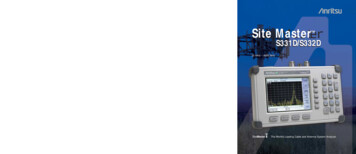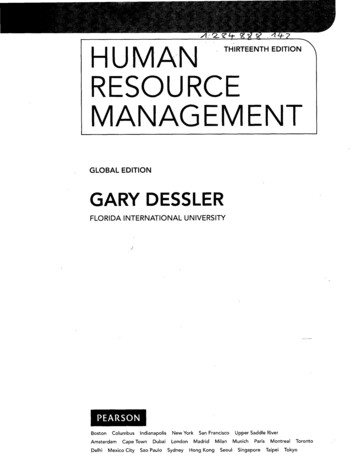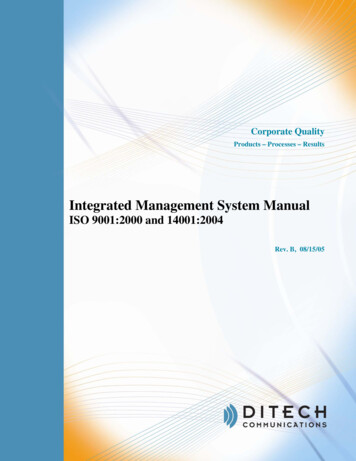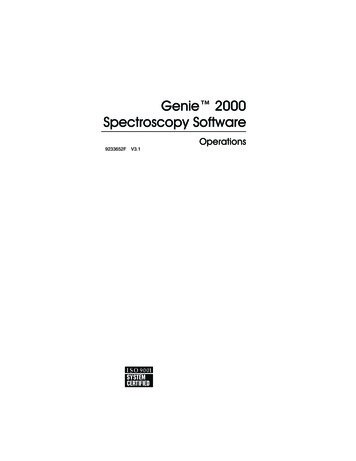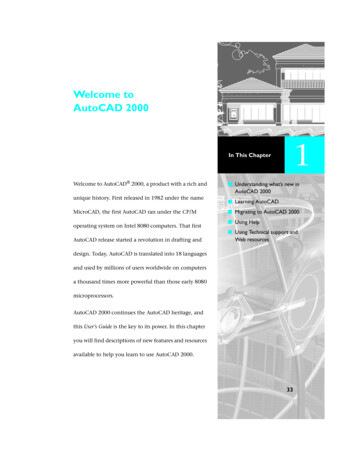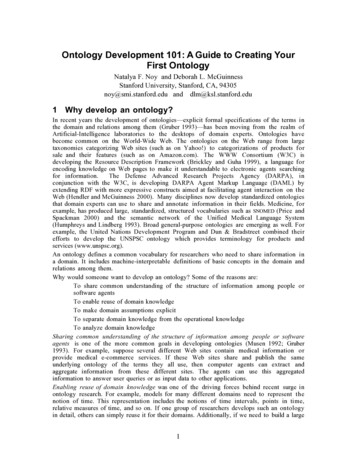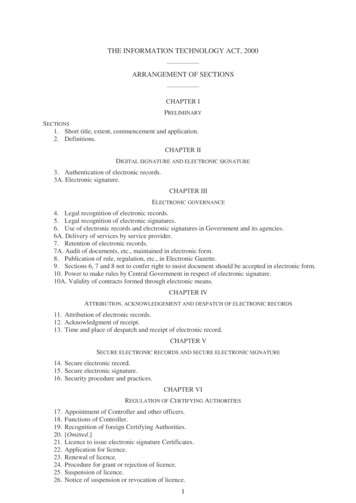
Transcription
THE INFORMATION TECHNOLOGY ACT, 2000–––––––––ARRANGEMENT OF SECTIONS–––––––––CHAPTER IPRELIMINARYSECTIONS1. Short title, extent, commencement and application.2. Definitions.CHAPTER IIDIGITAL SIGNATURE AND ELECTRONIC SIGNATURE3. Authentication of electronic records.3A. Electronic signature.CHAPTER IIIELECTRONIC GOVERNANCE4. Legal recognition of electronic records.5. Legal recognition of electronic signatures.6. Use of electronic records and electronic signatures in Government and its agencies.6A. Delivery of services by service provider.7. Retention of electronic records.7A. Audit of documents, etc., maintained in electronic form.8. Publication of rule, regulation, etc., in Electronic Gazette.9. Sections 6, 7 and 8 not to confer right to insist document should be accepted in electronic form.10. Power to make rules by Central Government in respect of electronic signature.10A. Validity of contracts formed through electronic means.CHAPTER IVATTRIBUTION, ACKNOWLEDGEMENT AND DESPATCH OF ELECTRONIC RECORDS11. Attribution of electronic records.12. Acknowledgment of receipt.13. Time and place of despatch and receipt of electronic record.CHAPTER VSECURE ELECTRONIC RECORDS AND SECURE ELECTRONIC SIGNATURE14. Secure electronic record.15. Secure electronic signature.16. Security procedure and practices.CHAPTER VIREGULATION OF CERTIFYING nt of Controller and other officers.Functions of Controller.Recognition of foreign Certifying Authorities.[Omitted.]Licence to issue electronic signature Certificates.Application for licence.Renewal of licence.Procedure for grant or rejection of licence.Suspension of licence.Notice of suspension or revocation of licence.1
SECTIONS27.28.29.30.31.32.33.34.Power to delegate.Power to investigate contraventions.Access to computers and data.Certifying Authority to follow certain procedures.Certifying Authority to ensure compliance of the Act, etc.Display of licence.Surrender of licence.Disclosure.CHAPTER VIIELECTRONIC SIGNATURE CERTIFICATES35.36.37.38.39.Certifying authority to issue electronic signature Certificate.Representations upon issuance of Digital signature Certificate.Suspension of Digital Signature Certificate.Revocation of Digital Signature Certificate.Notice of suspension or revocation.CHAPTER VIIIDUTIES OF SUBSCRIBERS40. Generating key pair.40A. Duties of subscriber of Electronic Signature Certificate.41. Acceptance of Digital Signature Certificate.42. Control of private key.CHAPTER IXPENALTIES AND ADJUDICATION43. Penalty and compensation for damage to computer, computer system, etc.43A. Compensation for failure to protect data.44. Penalty for failure to furnish information, return, etc.45. Residuary penalty.46. Power to adjudicate.47. Factors to be taken into account by the adjudicating officer.CHAPTER XTHE CYBER APPELLATE TRIBUNAL48. Establishment of Cyber Appellate Tribunal.49. Composition of Cyber Appellate Tribunal.50. Qualifications for appointment as Chairperson and Members of Cyber Appellate Tribunal.51. Term of office, conditions of service, etc., of Chairperson and Members.52. Salary, allowances and other terms and conditions of service of Chairperson and Members.52A. Powers of superintendence, direction, etc.52B. Distribution of business among Benches.52C. Power of Chairperson to transfer cases.52D. Decision by majority.53. Filling up of vacancies.54. Resignation and removal.55. Orders constituting Appellate Tribunal to be final and not to invalidate its proceedings.56. Staff of the Cyber Appellate Tribunal.57. Appeal to Cyber Appellate Tribunal.58. Procedure and powers of the Cyber Appellate Tribunal.59. Right to legal representation.60. Limitation.61. Civil court not to have jurisdiction.62. Appeal to High Court.63. Compounding of contraventions.2
SECTIONS64. Recovery of penalty.CHAPTER XIOFFENCES65. Tampering with computer source documents.66. Computer related offences.66A. Punishment for sending offensive messages through communication service, etc.66B. Punishment for dishonestly receiving stolen computer resource or communication device.66C. Punishment for identity theft.66D. Punishment for cheating by personation by using computer resource.66E. Punishment for violation of privacy.66F. Punishment for cyber terrorism.67. Punishment for publishing or transmitting obscene material in electronic form.67A. Punishment for publishing or transmitting of material containing sexually explicit act, etc., inelectronic form.67B. Punishment for publishing or transmitting of material depicting children in sexually explicit act,etc., in electronic form.67C. Preservation and retention of information by intermediaries.68. Power of Controller to give directions.69. Power to issue directions for interception or monitoring or decryption of any information throughany computer resource.69A. Power to issue directions for blocking for public access of any information through anycomputer resource.69B. Power to authorise to monitor and collect traffic data or information through any computerresource for cyber security.70. Protected system.70A. National nodal agency.70B. Indian Computer Emergency Response Team to serve as national agency for incident response.71. Penalty for misrepresentation.72. Penalty for Breach of confidentiality and privacy.72A. Punishment for disclosure of information in breach of lawful contract.73. Penalty for publishing electronic signature Certificate false in certain particulars.74. Publication for fraudulent purpose.75. Act to apply for offence or contravention committed outside India.76. Confiscation.77. Compensation, penalties or confiscation not to interfere with other punishment.77A. Compounding of offences.77B. Offences with three years imprisonment to be bailable.78. Power to investigate offences.CHAPTER XIIINTERMEDIARIES NOT TO BE LIABLE IN CERTAIN CASES79. Exemption from liability of intermediary in certain cases.CHAPTER XIIAEXAMINER OF ELECTRONIC EVIDENCE79A. Central Government to notify Examiner of Electronic Evidence.CHAPTER XIIIMISCELLANEOUS80. Power of police officer and other officers to enter, search, etc.81. Act to have overriding effect.81A. Application of the Act to electronic cheque and truncated cheque.82. Chairperson, Members, officers and employees to be public servants.83. Power to give directions.3
SECTIONS84. Protection of action taken in good faith.84A. Modes or methods for encryption.84B. Punishment for abetment of offences.84C. Punishment for attempt to commit offences.85. Offences by companies.86. Removal of difficulties.87. Power of Central Government to make rules.88. Constitution of Advisory Committee.89. Power of Controller to make regulations.90. Power of State Government to make rules.91. [Omitted].92. [Omitted].93. [Omitted].94. [Omitted].THE FIRST SCHEDULE.THE SECOND SCHEDULE.THE THIRD SCHEDULE. [Omitted.]THE FOURTH SCHEDULE. [Omitted.]4
THE INFORMATION TECHNOLOGY ACT, 2000ACT NO. 21 OF 2000[9th June, 2000.]An Act to provide legal recognition for transactions carried out by means of electronic datainterchange and other means of electronic communication, commonly referred to as“electronic commerce”, which involve the use of alternatives to paper-based methods ofcommunication and storage of information, to facilitate electronic filing of documents withthe Government agencies and further to amend the Indian Penal Code, the Indian EvidenceAct, 1872, the Banker’s Books Evidence Act, 1891 and the Reserve Bank of India Act, 1934and for matters connected therewith or incidental thereto;WHEREAS the General Assembly of the United Nations by resolution A/RES/51/162, dated the 30thJanuary, 1997 has adopted the Model Law on Electronic Commerce adopted by the United NationsCommission on International Trade Law;AND WHEREAS the said resolution recommends inter alia, that all States give favourableconsideration to the said Model Law when they enact or revise their laws, in view of the need foruniformity of the law applicable to alternatives to paper-based methods of communication and storage ofinformation;AND WHEREAS it is considered necessary to give effect to the said resolution and to promote efficientdelivery of Government services by means of reliable electronic records.BE it enacted by Parliament in the Fifty-first Year of the Republic of India as follows:–CHAPTER 1PRELIMINARY1. Short title, extent, commencement and application.–(1) This Act may be called the InformationTechnology Act, 2000.(2) It shall extend to the whole of India and, save as otherwise provided in this Act, it applies also toany offence or contravention thereunder committed outside India by any person.(3) It shall come into force on such date1 as the Central Government may, by notification, appoint anddifferent dates may be appointed for different provisions of this Act and any reference in any suchprovision to the commencement of this Act shall be construed as a reference to the commencement of thatprovision.2[(4) Nothing in this Act shall apply to documents or transactions specified in the First Schedule:Provided that the Central Government may, by notification in the Official Gazette, amend the FirstSchedule by way of addition or deletion of entries thereto.(5) Every notification issued under sub-section (4) shall be laid before each House of Parliament.]2. Definitions.–(1) In this Act, unless the context otherwise requires,–(a) “access” with its grammatical variations and cognate expressions means gaining entry into,instructing or communicating with the logical, arithmetical, or memory function resources of acomputer, computer system or computer network;(b) “addressee” means a person who is intended by the originator to receive the electronic recordbut does not include any intermediary;(c) “adjudicating officer” means an adjudicating officer appointed under sub-section (1) ofsection 46;1. 17th October, 2000, vide notification No. G.S.R. 788 (E), dated 17th October, 2000, see Gazette of India, Extraordinary,Part II, sec. 3(ii).2. Subs. by Act 10 of 2009, s. 3, for sub-section (4) (w.e.f. 27-10-2009).5
(d) “affixing 1[electronic signature]” with its grammatical variations and cognate expressionsmeans adoption of any methodology or procedure by a person for the purpose of authenticating anelectronic record by means of digital signature;(e) “appropriate Government” means as respects any matter,–(i) enumerated in List II of the Seventh Schedule to the Constitution;(ii) relating to any State law enacted under List III of the Seventh Schedule to theConstitution,the State Government and in any other case, the Central Government;(f) “asymmetric crypto system” means a system of a secure key pair consisting of a private keyfor creating a digital signature and a public key to verify the digital signature;(g) “Certifying Authority” means a person who has been granted a licence to issue a 1[electronicsignature] Certificate under section 24;(h) “certification practice statement” means a statement issued by a Certifying Authority tospecify the practices that the Certifying Authority employs in issuing 1[electronic signature]Certificates;[(ha) “communication device” means cell phones, personal digital assistance or combination ofboth or any other device used to communicate, send or transmit any text, video, audio or image;]2(i) “computer” means any electronic, magnetic, optical or other high-speed data processing deviceor system which performs logical, arithmetic, and memory functions by manipulations of electronic,magnetic or optical impulses, and includes all input, output, processing, storage, computer software orcommunication facilities which are connected or related to the computer in a computer system orcomputer network;[(j) “computer network” means the inter-connection of one or more computers or computersystems or communication device through–3(i) the use of satellite, microwave, terrestrial line, wire, wireless or other communicationmedia; and(ii) terminals or a complex consisting of two or more interconnected computers orcommunication device whether or not the inter-connection is continuously maintained;](k) “computer resource” means computer, computer system, computer network, data, computerdata base or software;(l) “computer system” means a device or collection of devices, including input and output supportdevices and excluding calculators which are not programmable and capable of being used inconjunction with external files, which contain computer programmes, electronic instructions, inputdata and output data, that performs logic, arithmetic, data storage and retrieval, communicationcontrol and other functions;(m) “Controller” means the Controller of Certifying Authorities appointed under sub-section (1)of section 17;(n) “Cyber Appellate Tribunal” means the Cyber 4*** Appellate Tribunal established undersub-section (1) of section 48;[(na) “cyber cafe” means any facility from where access to the internet is offered by any personin the ordinary course of business to the members of the public;2(nb) “cyber security means protecting information, equipment, devices, computer, computerresource, communication device and information stored therein from unauthorised access, use,disclosure, disruption, modification or destruction;]1. Subs. by Act 10 of 2009, s. 2, for “digital signature” (w.e.f. 27-10-2009).2. Ins. by s. 4, ibid. (w.e.f. 27-10-2009).3. Subs. by s. 4, ibid., for clause (j) (w.e.f. 27-10-2009).4. The word “Regulations” omitted by s. 4, ibid. (w.e.f. 27-10-2009).6
(o) “data” means a representation of information, knowledge, facts, concepts or instructionswhich are being prepared or have been prepared in a formalised manner, and is intended to beprocessed, is being processed or has been processed in a computer system or computer network, andmay be in any form (including computer printouts magnetic or optical storage media, punched cards,punched tapes) or stored internally in the memory of the computer;(p) “digital signature” means authentication of any electronic record by a subscriber by means ofan electronic method or procedure in accordance with the provisions of section 3;(q) “Digital Signature Certificate” means a Digital Signature Certificate issued under sub-section(4) of section 35;(r) “electronic form” with reference to information, means any information generated, sent,received or stored in media, magnetic, optical, computer memory, micro film, computer generatedmicro fiche or similar device;(s) “Electronic Gazette” means the Official Gazette published in the electronic form;(t) “electronic record” means data, record or data generated, image or sound stored, received orsent in an electronic form or micro film or computer generated micro fiche;[(ta) “electronic signature” means authentication of any electronic record by a subscriber bymeans of the electronic technique specified in the Second Schedule and includes digital signature;1(tb) “Electronic Signature Certificate” means an Electronic Signature Certificate issued undersection 35 and includes Digital Signature Certificate;](u) “function”, in relation to a computer, includes logic, control, arithmetical process, deletion,storage and retrieval and communication or telecommunication from or within a computer;1[(ua) Indian Computer Emergency Response Team” means an agency established under subsection (1) of Section 70B;](v) “information” includes 2[data, message, text,] images, sound, voice, codes, computerprogrammes, software and data bases or micro film or computer generated micro fiche;[(w) “intermediary”, with respect to any particular electronic records, means any person who onbehalf of another person receives, stores or transmits that record or provides any service with respectto that record and includes telecom service providers, network service providers, internet serviceproviders, web-hosting service providers, search engines, online payment sites, online-auction sites,online-market places and cyber cafes;]3(x) “key pair”, in an asymmetric crypto system, means a private key and its mathematicallyrelated public key, which are so related that the public key can verify a digital signature created by theprivate key;(y) “law” includes any Act of Parliament or of a State Legislature, Ordinances promulgated by thePresident or a Governor, as the case may be, Regulations made by the President under article 240,Bills enacted as President's Act under sub-clause (a) of clause (1) of article 357 of the Constitutionand includes rules, regulations, bye-laws and orders issued or made thereunder;(z) “licence” means a licence granted to a Certifying Authority under section 24;(za) “originator” means a person who sends, generates, stores or transmits any electronic messageor causes any electronic message to be sent, generated, stored or transmitted to any other person butdoes not include an intermediary;(zb) “prescribed” means prescribed by rules made under this Act;(zc) “private key” means the key of a key pair used to create a digital signature;(zd) “public key” means the key of a key pair used to verify a digital signature and listed in theDigital Signature Certificate;1. Ins. by Act 10 of 2009 s. 4 (w.e.f. 27-10-2009).2. Subs. by s. 4, ibid., for “data, text”, (w.e.f. 27-10-2009).3. Subs. by s. 4, ibid., for clause (w), (w.e.f. 27-10-2009).7
(ze) “secure system” means computer hardware, software, and procedure that–(a) are reasonably secure from unauthorised access and misuse;(b) provide a reasonable level of reliability and correct operation;(c) are reasonably suited to performing the intended functions; and(d) adhere to generally accepted security procedures;(zf) “security procedure” means the security procedure prescribed under section 16 by the CentralGovernment;(zg) “subscriber” means a person in whose name the 1[electronic signature] Certificate is issued;(zh) “verify”, in relation to a digital signature, electronic record or public key, with itsgrammatical variations and cognate expressions, means to determine whether–(a) the initial electronic record was affixed with the digital signature by the use of private keycorresponding to the public key of the subscriber;(b) the initial electronic record is retained intact or has been altered since such electronicrecord was so affixed with the digital signature.(2) Any reference in this Act to any enactment or any provision thereof shall, in relation to an area inwhich such enactment or such provision is not in force, be construed as a reference to the correspondinglaw or the relevant provision of the corresponding law, if any, in force in that area.CHAPTER II2[DIGITAL SIGNATURE AND ELECTRONIC SIGNATURE]3. Authentication of electronic records.–(1) Subject to the provisions of this section any subscribermay authenticate an electronic record by affixing his digital signature.(2) The authentication of the electronic record shall be effected by the use of asymmetric cryptosystem and hash function which envelop and transform the initial electronic record into another electronicrecord.Explanation.–For the purposes of this sub-section, “hash function” means an algorithm mapping ortranslation of one sequence of bits into another, generally smaller, set known as “hash result” such that anelectronic record yields the same hash result every time the algorithm is executed with the same electronicrecord as its input making it computationally infeasible–(a) to derive or reconstruct the original electronic record from the hash result produced by thealgorithm;(b) that two electronic records can produce the same hash result using the algorithm.(3) Any person by the use of a public key of the subscriber can verify the electronic record.(4) The private key and the public key are unique to the subscriber and constitute a functioning keypair.3[3A. Electronic signature.–(1) Notwithstanding anything contained in section 3, but subject to theprovisions of sub-section (2), a subscriber may authenticate any electronic record by such electronicsignature or electronic authentication technique which–(a) is considered reliable; and(b) may be specified in the Second Schedule.(2) For the purposes of this section any electronic signature or electronic authentication techniqueshall be considered reliable if–(a) the signature creation data or the authentication data are, within the context in which they areused, linked to the signatory or, as the case may be, the authenticator and to no other person;1. Subs. by Act 10 of 2009, s. 2, for “digital signature” (w.e.f. 27-10-2009).2. Subs. by s. 5, ibid., for the heading “DIGITAL SIGNATURE” (w.e.f. 27-10-2009).3. Ins. by s. 6, ibid. (w.e.f. 27-10-2009).8
(b) the signature creation data or the authentication data were, at the time of signing, under thecontrol of the signatory or, as the case may be, the authenticator and of no other person;(c) any alteration to the electronic signature made after affixing such signature is detectable;(d) any alteration to the information made after its authentication by electronic signature isdetectable; and(e) it fulfils such other conditions which may be prescribed.(3) The Central Government may prescribe the procedure for the purpose of ascertaining whetherelectronic signature is that of the person by whom it is purported to have been affixed or authenticated.(4) The Central Government may, by notification in the Official Gazette, add to or omit anyelectronic signature or electronic authentication technique and the procedure for affixing such signaturefrom the Second Schedule:Provided that no electronic signature or authentication technique shall be specified in the SecondSchedule unless such signature or technique is reliable.(5) Every notification issued under sub-section (4) shall be laid before each House of Parliament.]CHAPTER IIIELECTRONIC GOVERNANCE4. Legal recognition of electronic records.–Where any law provides that information or any othermatter shall be in writing or in the typewritten or printed form, then, notwithstanding anything containedin such law, such requirement shall be deemed to have been satisfied if such information or matter is–(a) rendered or made available in an electronic form; and(b) accessible so as to be usable for a subsequent reference.5. Legal recognition of 1[electronic signatures].–Where any law provides that information or anyother matter shall be authenticated by affixing the signature or any document shall be signed or bear thesignature of any person, then, notwithstanding anything contained in such law, such requirement shall bedeemed to have been satisfied, if such information or matter is authenticated by means of 1[electronicsignature] affixed in such manner as may be prescribed by the Central Government.Explanation.–For the purposes of this section, “signed”, with its grammatical variations and cognateexpressions, shall, with reference to a person, mean affixing of his hand written signature or any mark onany document and the expression “signature” shall be construed accordingly.6. Use of electronic records and 1[electronic signatures] in Government and its agencies.–(1)Where any law provides for–(a) the filing of any form, application or any other document with any office, authority, body oragency owned or controlled by the appropriate Government in a particular manner;(b) the issue or grant of any licence, permit, sanction or approval by whatever name called in aparticular manner;(c) the receipt or payment of money in a particular manner,then, notwithstanding anything contained in any other law for the time being in force, such requirementshall be deemed to have been satisfied if such filing, issue, grant, receipt or payment, as the case may be,is effected by means of such electronic form as may be prescribed by the appropriate Government.(2) The appropriate Government may, for the purposes of sub-section (1), by rules, prescribe–(a) the manner and format in which such electronic records shall be filed, created or issued;(b) the manner or method of payment of any fee or charges for filing, creation or issue anyelectronic record under clause (a).1. Subs. by Act 10 of 2009, s. 2, for “digital signatures” (w.e.f. 27-10-2009).9
1[6A. Delivery of services by service provider.–(1) The appropriate Government may, for thepurposes of this Chapter and for efficient delivery of services to the public through electronic meansauthorise, by order, any service provider to set up, maintain and upgrade the computerised facilities andperform such other services as it may specify, by notification in the Official Gazette.Explanation.–For the purposes of this section, service provider so authorised includes any individual,private agency, private company, partnership firm, sole proprietor firm or any such other body or agencywhich has been granted permission by the appropriate Government to offer services through electronicmeans in accordance with the policy governing such service sector.(2) The appropriate Government may also authorise any service provider authorised under subsection (1) to collect, retain and appropriate such service charges, as may be prescribed by the appropriateGovernment for the purpose of providing such services, from the person availing such service.(3) Subject to the provisions of sub-section (2), the appropriate Government may authorise the serviceproviders to collect, retain and appropriate service charges under this section notwithstanding the fact thatthere is no express provision under the Act, rule, regulation or notification under which the service isprovided to collect, retain and appropriate e-service charges by the service providers.(4) The appropriate Government shall, by notification in the Official Gazette, specify the scale ofservice charges which may be charged and collected by the service providers under this section:Provided that the appropriate Government may specify different scale of service charges for differenttypes of services.]7. Retention of electronic records.–(1) Where any law provides that documents, records orinformation shall be retained for any specific period, then, that requirement shall be deemed to have beensatisfied if such documents, records or information are retained in the electronic form, if–(a) the information contained therein remains accessible so as to be usable for a subsequentreference;(b) the electronic record is retained in the format in which it was originally generated, sent orreceived or in a format which can be demonstrated to represent accurately the information originallygenerated, sent or received;(c) the details which will facilitate the identification of the origin, destination, date and time ofdespatch or receipt of such electronic record are available in the electronic record:Provided that this clause does not apply to any information which is automatically generatedsolely for the purpose of enabling an electronic record to be despatched or received.(2) Nothing in this section shall apply to any law that expressly provides for the retention ofdocuments, records or information in the form of electronic records.2[7A. Audit of documents, etc., maintained in electronic form.–Where in any law for the timebeing in force, there is a provision for audit of documents, records or information, that provision shall alsobe applicable for audit of documents, records or information processed and maintained in the electronicform.]8. Publication of rule, regulation, etc., in Electronic Gazette.–Where any law provides that anyrule, regulation, order, bye-law, notification or any other matter shall be published in the Official Gazette,then, such requirement shall be deemed to have been satisfied if such rule, regulation, order, bye-law,notification or any other matter is published in the Official Gazette or Electronic Gazette:Provided that where any rule, regulation, order, by-law, notification or any other matter is publishedin the Official Gazette or Electronic Gazette, the date of publication shall be deemed to be the date of theGazette which was first published in any form.9. Sections 6, 7 and 8 not to confer right to insist document should be accepted in electronicform.–Nothing contained in sections 6, 7 and 8 shall confer a right upon any person to insist that anyMinistry or Department of the Central Government or the State Government or any authority or bodyestablished by or under any law or controlled or funded by the Central or State Government should1. Ins. by Act 10 of 2009 s. 7 (w.e.f. 27-10-2009).2. Ins. by s. 8, ibid. (w.e.f. 27-10-2009).10
accept, issue, create, retain and preserve any document in the form of electronic records or effect anymonetary transaction in the electronic form.10. Power to make rules by Central Government in respect of 1[electronic signature].–TheCentral Government may, for the purposes of this Act, by rules, prescribe–(a) the type of 1[electronic signature];(b) the manner and format in which the 1[electronic signature] shall be affixed;(c) the manner or procedure which facilitates identification of the person affixing the 1[electronicsignature];(d) control processes and procedures to ensure adequate integrity, security and confidentiality ofelectronic records or payments; and(e) any other matter which is necessary to give legal effect to 1[electronic signatures].2[10A. Validity of contracts formed through electronic means.–Where in a contract formation, thecommunication of proposals, the acceptance of proposals, the revocation of proposals and acceptances, asthe case may be, are expressed in electronic form or by means of an electronic records, such contract shallnot be deemed to be unenforceable solely on the ground that such electronic form or means was used forthat purpose.]CHAPTER IVATTRIBUTION, ACKNOWLEDGMENT AND DESPATCH OF ELECTRONIC RECORDS11. Attribution of electronic records.–An electronic record shall be attributed to the originator–(a) if it was sent by the originator himself;(b) by a pers
5 THE INFORMATION TECHNOLOGY ACT, 2000 ACT NO. 21 OF 2000 [9th June, 2000.] An Act to provide legal recognition for transactions carried out by means of electronic data interchange and other m


